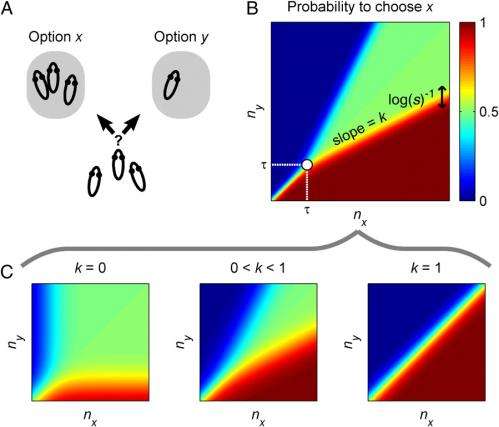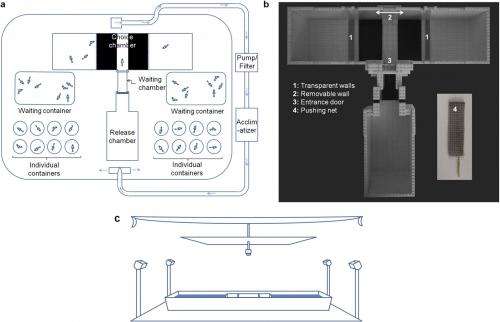December 18, 2012 feature
All together now: Single rule accounts for diverse decision systems in animal collectives

(Phys.org)—Ethologists – those who study animal behavior under natural conditions – have long recognized that groups of various species, or animal collectives, use a variety of decision-making systems. For example, some species choose from among various behavioral options based on the number of animals that have already selected each alternative; other species follow Weber's Law, in which the relative number is the deciding factor; and for others, more complicated rules are involved. Recently, however, scientists at Instituto Cajal, Consejo Superior de Investigaciones Científicas, Spain, identified a single Bayesian-based decision-making rule underlying this observed diversity. Moreover, the researchers then experimentally demonstrated that this single rule quantitatively explains decision-making in zebrafish, and in existing datasets of argentine ants and sticklebacks. This suggests, they conclude, that decision-making based not just on individual behavioral, neurobiological, and psychological factors, but on social information, obtains across species – including humans.
Dr. Gonzalo G. de Polavieja, Dr. Sara Arganda and doctoral student Alfonso Pérez-Escudero faced a variety of challenges in their study. "I started, together with Alfonso, to think about how to generate a theory of how individuals decide in groups," de Polavieja tells Phys.org. "It seemed to us that estimation of which of the available options to take using the behaviors of other animals was a good starting point. I knew from years of work in Neurobiology that all brains need to make estimations about the structure of the world from ambiguous sensory data. From this simple idea, we worked out the mathematics."
The researchers used mathematics known as Bayesian estimation, but they generalized the equations to handle the case of an animal using other animals to improve estimations – and the mathematics they obtained were simple enough to make comparisons with data.
"We then used data on sticklebacks, from Dr. Ashley Ward and his collaborators at the University of Sidney in Australia, to compare our rule with data – and it worked very well," de Polavieja continues. "This gave us confidence to try our own experiments in zebrafish – but the theory failed this time. Then we made an apparently subtle change in our theory. Until this point we'd assumed that an animal was estimating which option was best to take, but then developed a very similar theory that estimated whether an option was a good one."

Surprisingly, this subtle change led to different mathematics that closely matched both the stickleback and zebrafish data. Confident in their new rule, the team tried using existing data in the Argentine ant obtained by Dr. Andrea Perna and his collaborators at Uppsala University in Sweden. "Beautiful, it worked again," says de Polavieja. "We'd found that a simple neural property could give us a rule for behavior in collectives that matched data very well for very different species."
De Polavieja notes that their key innovation was theoretical. "Most previous rules were proposed as phenomenological rules to fit data," he explains. "Here we'd proposed to base these kinds of rules on Bayesian estimation, and had taken the right steps to obtain a rule that worked very well when compared to data."
One of the study's key findings was that the different counting systems used by animals, including humans, can emerge from the common principle of using social information to make good decisions. "It turns out that both absolute and relative counting systems found experimentally are derived from our theory as particular cases," de Polavieja explains. "This came as a surprise, as it's not clear that social interactions are behind counting – but note that social interactions can be so important for survival that they might have a great impact on how animals count."
The scientists are already charting their future research directions. "We're doing theoretical and experimental innovations," de Polavieja points out. "The main ones relate to more natural experiments in which animals move in space-time and not simply choose among a discrete set of options. We're extending the theory to cope with this general case and working on a tracking system to automatically follow each animal in a group." In addition, they're using their results to ask some basic questions, such as Why do animals aggregate? Which neural circuits most influence collective behavior? "We're moving in both directions."
De Polavieja also sees their findings having a wider impact. "We're in the early stages of testing these results in human data," he concludes. "We're comparing our theoretical results with existing data on how humans get influenced by others – and since it's proving successful, we'll soon start our own experiments. I dream of being able to produce a theory that could help humans make group decisions."
More information: A common rule for decision making in animal collectives across species, PNAS December 11, 2012 vol. 109 no. 50 20508-20513, doi:10.1073/pnas.1210664109
Journal information: Proceedings of the National Academy of Sciences
Copyright 2012 Phys.org
All rights reserved. This material may not be published, broadcast, rewritten or redistributed in whole or part without the express written permission of Phys.org.



















